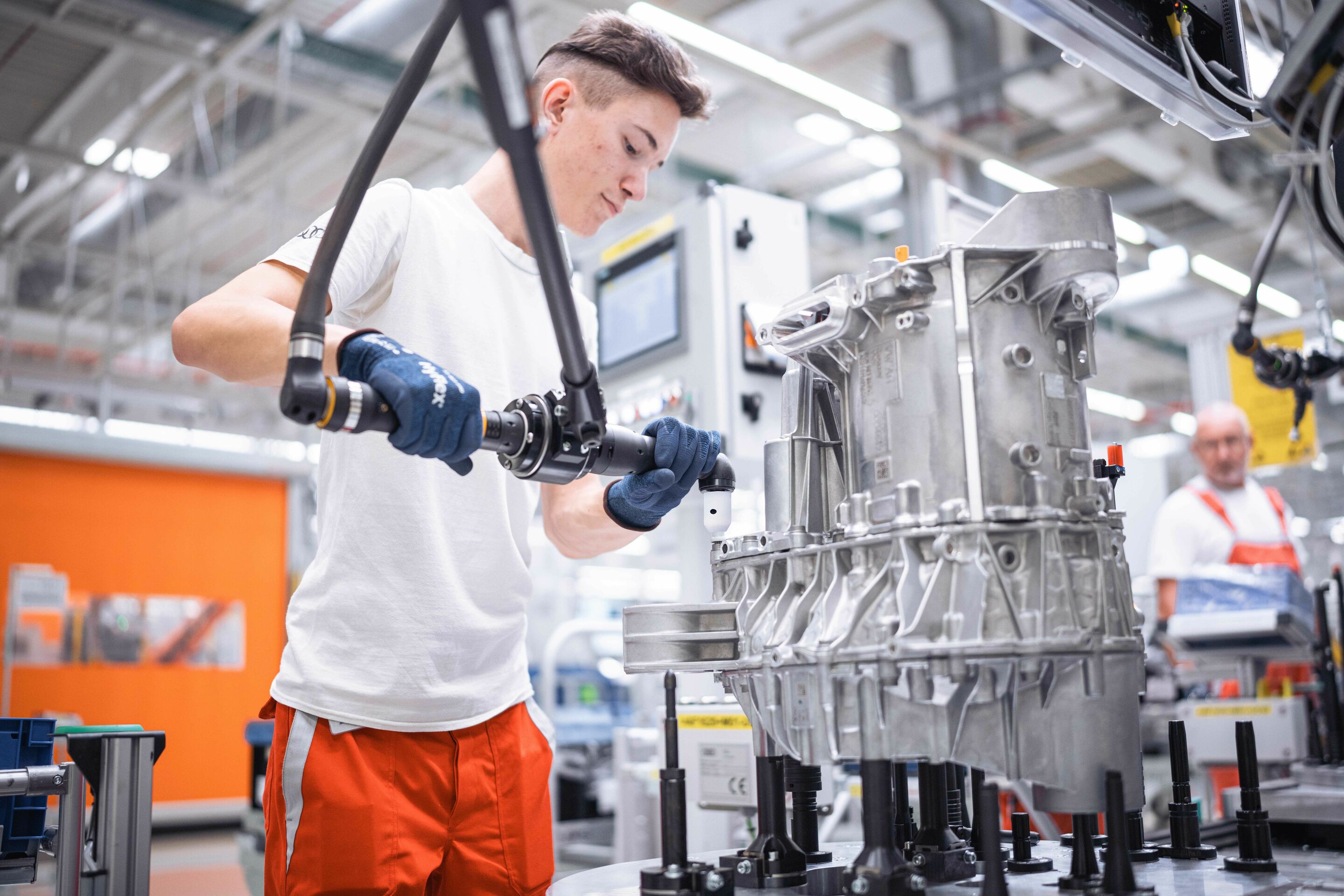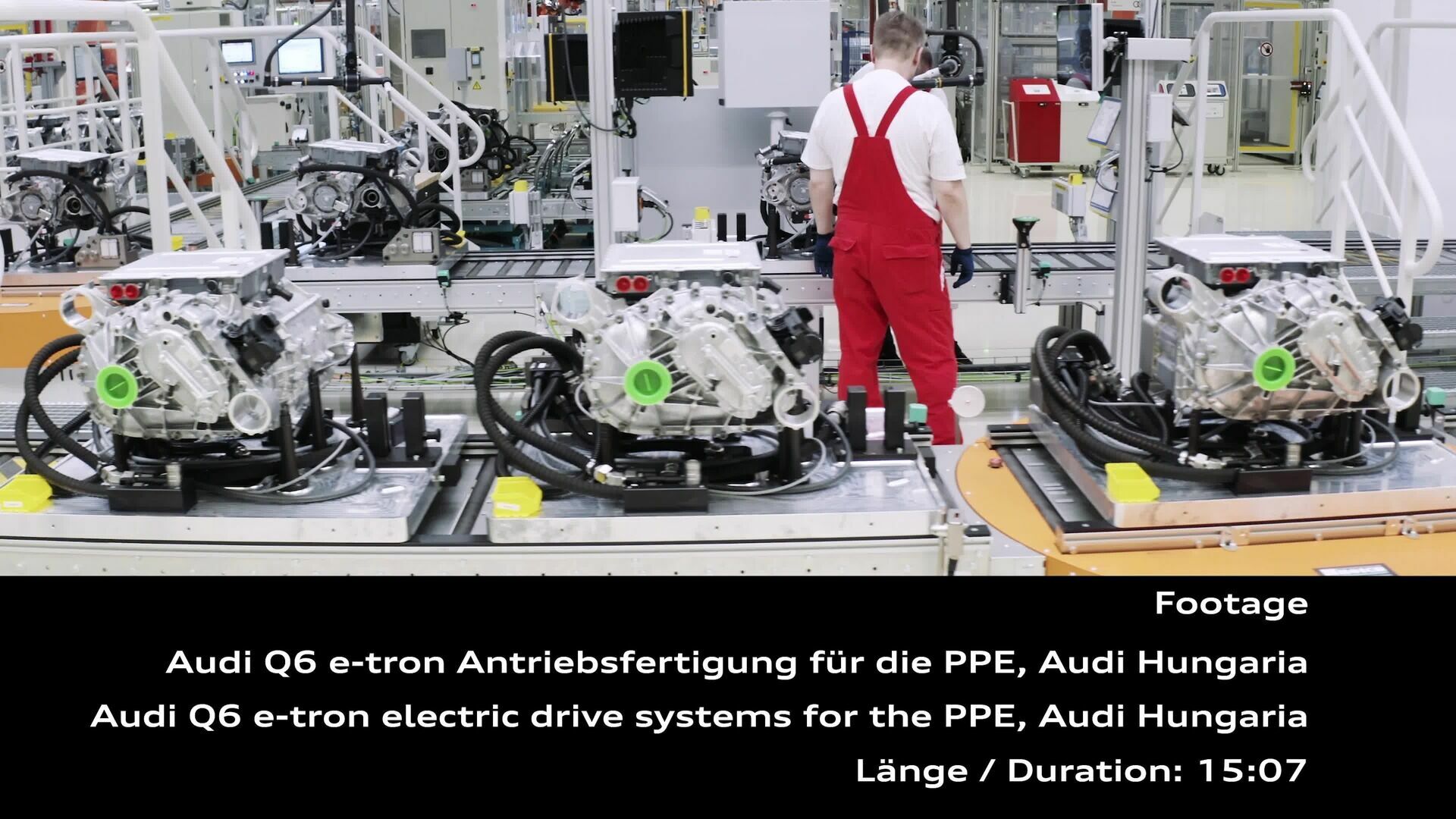Sustainable production and materials
Back to overviewAudi Production is using the switch to e-mobility for a comprehensive transformation of the global production network and has a clear vision for the production of the future with the 360factory. Audi is pursuing a holistic, sustainable approach and is modernizing, digitalizing, and transforming its existing plants. Since 2020, the plant in Győr, Hungary, has been producing net carbon neutrally1 with the largest photovoltaic roof system in Europe and is the largest user of industrial geothermal energy in Hungary. Audi transports the electric motors for the PPE from Győr to Ingolstadt net carbon neutrally1 with the transport and logistics company DB Cargo.
The Audi plant in Ingolstadt has been net carbon-neutral1 since January 1, 2024, making it the third Audi plant to make the switch after Brussels (2018) and Győr (2020). As part of its Mission:Zero environmental program, Audi has set itself the goal of achieving net carbon neutrality1 at all sites worldwide by 2025.
Audi uses recycled materials for a number of components in the Audi Q6 e-tron. These materials, which are prepared using a recycling process, reduce the use of resources and ensure a closed and, therefore, efficient and sustainable material cycle. Based on currently planned production figures, they are to be used over the entire service life of the Audi Q6 e-tron.
For example, the fabrics used for the Softwrap in the interior are partly based on sustainable materials. In the S line variant, the recycled fabric Elastic Melange, which is made from 100 percent recycled polyester, is used in the Softwrap. In addition to the seats and the Softwrap, Elastic Melange is also used for the door mirror. The headliner, pillars, and sun visors are made from Draft fabric, which is also made from 100% recycled polyester.
Components containing recycled materials are also used elsewhere. Examples of this are the sound generators, which produce the exterior sound in a similar way to loudspeakers, or the large storage compartment under the front flap, the so-called frunk. The adjacent covers and trim parts are made partly from recycled plastic. Another completely new plastic component in the front end is the area below the windscreen surrounding the fresh air intake. Here, a previously used sheet metal has been replaced by plastic components with a large proportion of secondary material.
Production processes provide a view to a circular economy
To produce the steel required for all variants of the outer roof section, Audi uses steel scrap, some of which comes from end-of-life vehicles previously in use by customers. Its proportion of steel production averages up to 15 percent (mass balance approach based on currently planned production figures).
The roof section is a good example of how Audi intends to use more post-consumer secondary materials in its products in the future. At the same time, this process provides an outlook for the circular economy at Audi. In this way, the four Rings reduce downcycling, i.e., the loss of the quality of materials in the recycling process, in the best possible way. Audi's vision is to reuse as many materials as possible, for example, from end-of-life vehicles, for the production of new vehicles. Maintaining materials’ high quality for as long as possible is a key objective of Audi's strategy.
Audi also sets specific CO2 targets for the identified hotspot materials and components from its suppliers. Reducing CO2 emissions in the supply chain will, therefore, become a central goal of future Audi vehicle projects. For example, the suppliers of battery cells for the vehicle projects based on the new PPE have committed to using green electricity in production. In addition, suppliers are using CO2-reduced aluminum for selected aluminum components, for example in the body.
Integration of the production steps
The Q6 e-tron family is the first fully electric high-volume model series that Audi is producing at its headquarters in Ingolstadt. In line with the 360factory production strategy, the company is focusing on integrating the individual production steps in body construction and assembly into existing structures and processes. Five-hundred new colleagues have been hired at the Ingolstadt production facility.
State-of-the-art production technology in new battery assembly
One example of how Audi is modernizing production and expanding existing structures is the new battery assembly facility for the PPE models. On an area of around 30,000 square meters (320,000 sq ft), around 300 employees assemble up to 1,000 high-voltage batteries per day in a three-shift operation with an automation rate of almost 90 percent - initially for the Q6 e-tron series. At the same time, the four rings are gaining important experience the company intends to use in production of its own battery modules in the future. The employees are already benefiting from the experience of their colleagues from the production of the Q8 e-tron in Brussels and the expertise of the battery technology center in Gaimersheim. "We are not only increasing our vertical range of manufacture but also bringing additional skills and technologies to the site," says Gerd Walker, Member of the Board of Management for Production.
The new facility in a building specially prepared for battery assembly in the Logistics and Transport Center (GVZ) in Ingolstadt is powered exclusively by green electricity. Audi is also achieving even greater flexibility and efficiency in production without having to seal additional land for new buildings.
E-motors for PPE from the world's largest drive plant in Győr
Ingolstadt receives the electric motors for the new Premium Platform Electric from the world's largest powertrain plant in Győr, Hungary. Audi Hungaria manufactures electric motors for the PPE on three newly installed production lines, which the transport company DB Cargo delivers to Ingolstadt in a net carbon-neutral way. In manufacturing of the new Q6 e-tron series, carbon-neutral production is an important milestone. Audi has been producing net carbon neutrally1 at the Győr site since 2020. “Sustainable production in existing plants is the core of our 360factory manufacturing strategy and an integral step on our path towards building a future-proof production network,” says Walker.
Retooling and flexible system in car body construction
In order to produce the Q6 e-tron series sustainably and efficiently, Audi has integrated production areas such as the body shop for the PPE into existing structures. The bodies for the PPE models are produced on an area of around 148,000 square meters (almost 1,600,000 sq ft) at the Ingolstadt plant. Shifts of 328 employees and 1,150 robots produce the body components for the Q6 e-tron series with a degree of automation of 87 percent. The highly flexible plant also enables the almost seamless ramp-up of future models. In order to use resources sustainably and synergistically, Audi is reusing 680 robots, which were already used in the production of other Audi models, in the body shop for the production of the PPE bodies. Audi is also commissioning a fleet of more than 40 automated guided vehicles (AGVs) for the Q6 e-tron model series. The AGVs will take over the provision of materials in the facility and automatically supply the systems in the body shop with the necessary parts.
Installation of PPE models in existing systems
Audi consistently uses existing structures and systems in assembly. The four Rings have seamlessly integrated the Audi Q6 e-tron model series into the existing assembly line for the Audi A4 and A5 models. Combustion-engine models and electric vehicles from different model series are thus produced on a common production line. Audi integrated the PPE models into this assembly line in eight conversion steps.
Higher degree of automation in the paint shop
Production has also extended the paint shop for the new fully electric series. Among other changes, the dryer after the cathodic dip coating (CDC) process step was extended and a new integrated procedure for automatically sealing holes was introduced. After CDC, robots use adhesive pads to seal about 70 holes in the bodies, each of which is measured individually for this step. Previously, employees had to manually perform this part of the process. Audi upgraded the dryer to meet the higher energy requirements for curing the bodies after CDC.
This modification ensures all parts of the body reach the target temperature of 160 °C (320 °F) required for curing the CDC. The Ingolstadt paint shop also uses automated production technology that helps detect, evaluate, and process surface irregularities. This makes it possible to objectively inspect finished surfaces, increasing process reliability and making quality monitoring more transparent.
In the first step, robots scan the vehicle surfaces using an automated measuring system. This process is the basis for finishing, which is also an automated process. Each finishing robot is equipped with a grinding and polishing tool. In the subsequent step, employees inspect the processed areas on large screens.
Flexible system concept for hot forming
At the press shop in Münchsmünster, many experts worked intensively to upgrade the hot forming process for PPE. This process is primarily used to produce safety-relevant components. This is because sheet metal parts for the body structure of the vehicles on the PPE, such as A and B pillars, as well as parts of the side member, are given special stability and crash safety through hot forming. After being heated to around 950 degrees Celsius (1,742 °F) in a special furnace, sheet metal strips are formed into a component in a forming press with an associated forming tool. By locally cooling the heated metal using air vents, Audi can influence the strength of the components as needed to further optimize crash performance while reducing the weight of the body. The hardness of the material makes it necessary for the components to be subsequently cut to the required contours using special lasers. In addition to components for models based on the PPE, components for models based on the PPC (Premium Platform Combustion) combustion-engine platform will also be manufactured by these production systems in the future. Thanks to their newly achieved flexibility, it will be possible to produce a total of 44 different components in Münchsmünster. Set-up changes at the laser cells and forming presses are fully automatic and take place in the shortest possible time, meaning that around 20,000 individual parts can leave the plant per working day.
1 Audi understands net-zero CO2 emissions to mean a situation in which, after other possible reduction measures have been exhausted, the company offsets the carbon emitted by Audi’s products or activities and/or the carbon emissions that currently cannot be avoided in the supply chain, manufacturing, and recycling of Audi vehicles through voluntary offsetting projects carried out worldwide. In this context, carbon emissions generated during a vehicle’s utilization stage, i.e. from the moment it is delivered to the customer, are not taken into account.
The equipment, data and prices specified in this document refer to the model range offered in Germany. Subject to change without notice; errors and omissions excepted.

